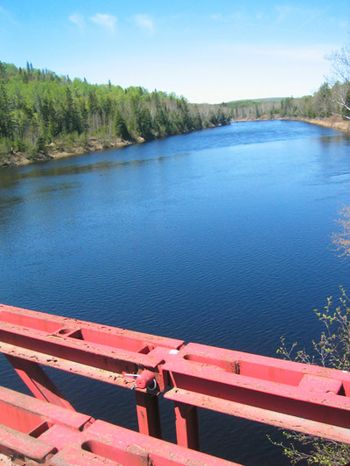Gens de Terre River facts for kids
Quick facts for kids Gens de Terre River |
|
|---|---|
 |
|
| Other name(s) | Rivière Gens de Terre |
| Country | Canada |
| State | Quebec |
| Region | Outaouais |
| Physical characteristics | |
| Main source | Cabonga Reservoir 355 m (1,165 ft) 47°18′34″N 76°28′6″W / 47.30944°N 76.46833°W |
| River mouth | Baskatong Reservoir 235 m (771 ft) 46°52′6″N 75°57′18″W / 46.86833°N 75.95500°W |
| Length | 115 km (71 mi) |
The Gens de Terre River (which means "people of the land" in French) is a cool river in central Quebec, Canada. It flows along the eastern side of the La Vérendrye Wildlife Reserve. This river starts from the Cabonga Reservoir and travels about 115 kilometers (71 miles) south. It finally empties into the Gens de Terre Bay, which is part of the big Baskatong Reservoir.
The Gens de Terre River has several smaller rivers that flow into it. These are called tributaries:
- Bélinge River
- Wapus River
- Serpent River
River Features
A special part of the river is found between the Wapus River and an iron bridge further downstream. Here, the river flows through a narrow gorge. This gorge has tall cliffs on both sides, reaching about 25 meters (82 feet) high!
This section is about 25 kilometers (15 miles) long. It has many exciting whitewater rapids, from easy to very challenging. Because of these rapids, only expert canoers should try to paddle this part of the river. The amount of water flowing in the river changes a lot. It depends on how much water is released from the Cabonga Reservoir.
A Look Back in Time: History of the River
The name "Gens de Terre" likely comes from Louis Antoine de Bougainville (1729-1811). He was a helper to a famous general named Marquis de Montcalm. In 1757, Bougainville wrote in his journal about a group of Indigenous people. He called them "Têtes-de-Boule" and also "people of the land" (gens des terres).
These people lived in the woods and were great hunters. They traded with both the French and the English near Hudson Bay. The name "Gens de Terre" was probably given by early explorers or fur traders. It reminded them of this nomadic tribe. Their land stretched between the upper parts of the Saint-Maurice River, Gatineau River, and Ottawa River. This name has been used in official papers since at least 1867.
In the early 1900s, English speakers sometimes called this river the "Bark River."
For a long time, the river was used by loggers. They would float cut trees downstream in a process called log driving. The log drivers even had a nickname for the river: La Maline, which means "the malignant" or "the tricky one." This was because of all the difficult obstacles and challenges they faced along the river's path.

